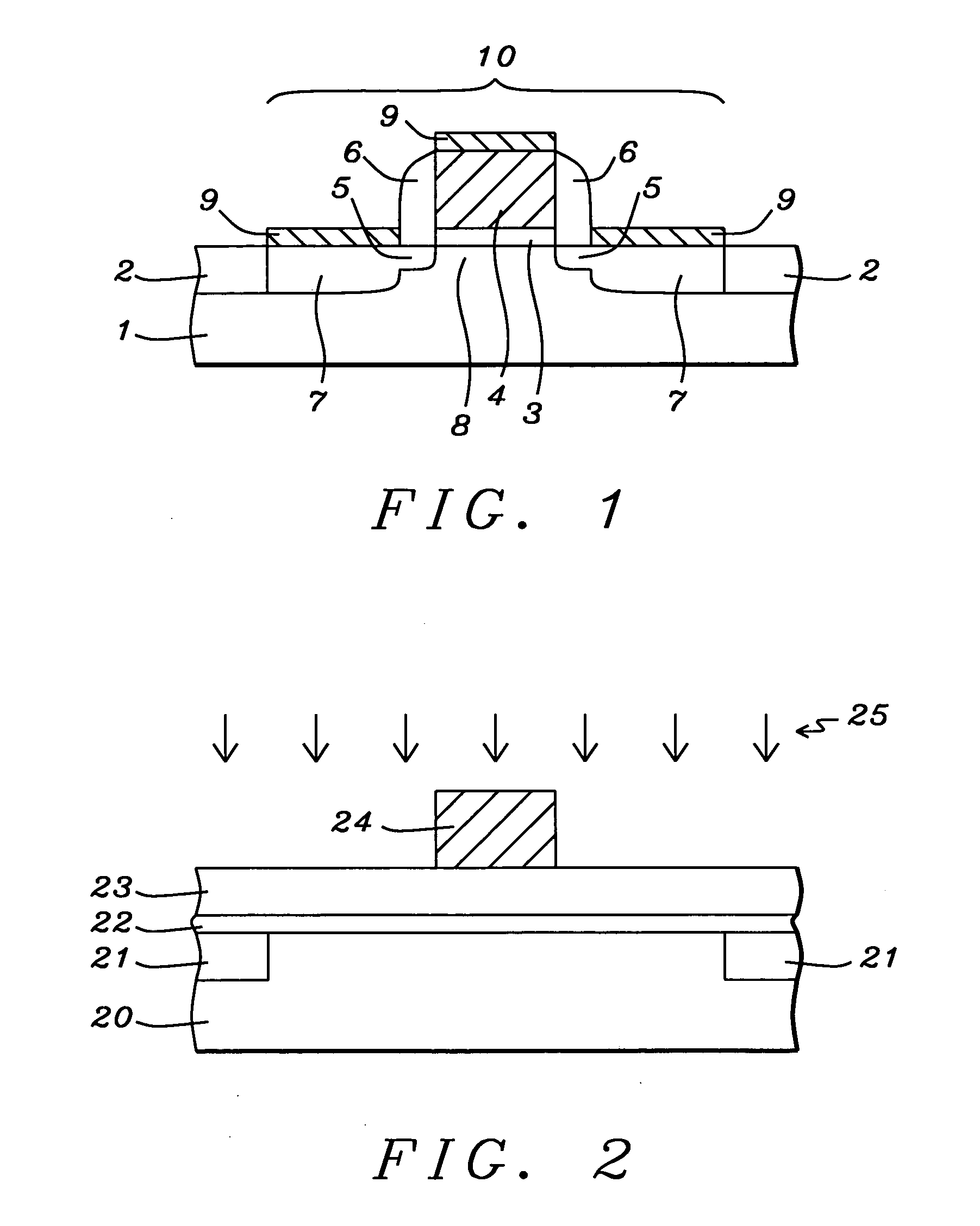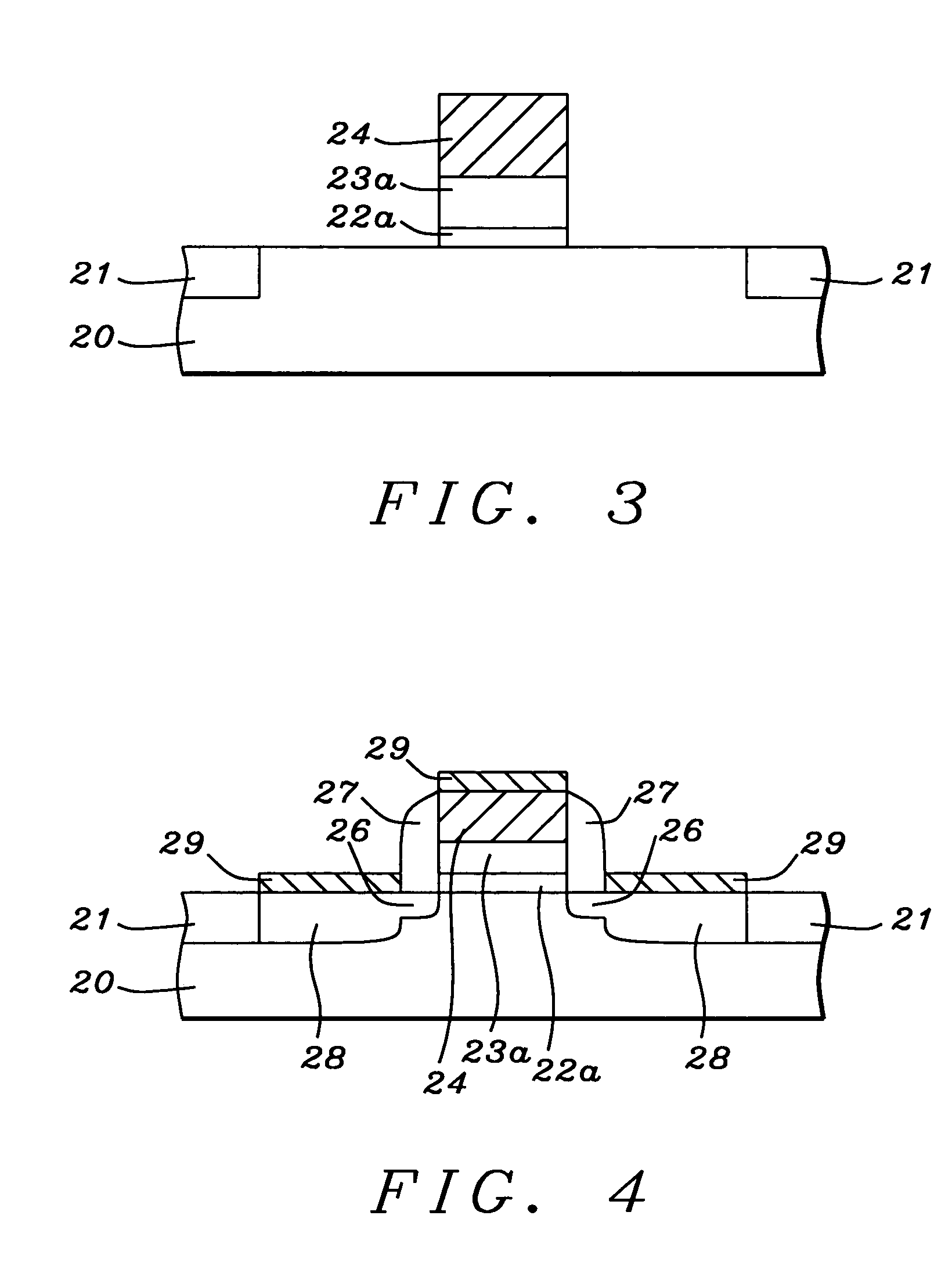Zirconium oxide and hafnium oxide etching using halogen containing chemicals
a technology of hafnium oxide and zirconium oxide, which is applied in the direction of semiconductor devices, basic electric elements, electrical equipment, etc., can solve the problems of inability to avoid the problem of tunneling current, inability to remove the over isolation region easily, and conventional plasma etching methods do not provide a high selective level for zrosub>2 /sub>or hfo
- Summary
- Abstract
- Description
- Claims
- Application Information
AI Technical Summary
Benefits of technology
Problems solved by technology
Method used
Image
Examples
first embodiment
[0026] The first embodiment is set forth in FIGS. 2-4. Referring to FIG. 2, a substrate 20 is provided which may include active and passive devices. Substrate 20 is typically silicon and has an n-well or a p-well (not shown) depending on the type of transistor that will subsequently be formed. Isolation regions 21 are formed in the substrate 20 by conventional methods and are generally comprised of silicon oxide or a low k dielectric material such as carbon doped SiO2 or fluorine doped SiO2. In the exemplary embodiment, an isolation region 21 is shown as a shallow trench isolation (STI) region but optionally may be a field oxide (FOX) structure or a mesa isolation region. In one embodiment, a thin interfacial layer 22 with a thickness between about 1 and 30 Angstroms is deposited on substrate 20 and is comprised of a material such as silicon oxide, silicon nitride or silicon oxynitride. The interfacial layer 22 is preferably formed by a rapid thermal process (RTP) although a low pre...
second embodiment
[0037] the invention involves the use of a high k dielectric layer as a hard mask during a pattern transfer process. The second embodiment is illustrated in FIGS. 5-7. Referring to FIG. 5, a substrate 30 is provided which may include active and passive devices. Substrate 30 may be comprised of silicon, SiGe, silicon-on-insulator (SOI), or other semiconductor materials used in the art. Optionally, the substrate 30 may be a dielectric layer or a semiconductive material. In another embodiment, a thin interfacial layer (not shown) such as silicon nitride, silicon oxide, or silicon oxynitride is formed on the substrate 30 by a CVD or PECVD process. An interfacial layer is employed to provide a smoother interface between the substrate 30 and an overlying high k dielectric layer 31.
[0038] A high k dielectric layer 31 which is preferably a zirconium or hafnium oxide, silicate, nitride or oxynitride is deposited by an ALD, CVD, or MOCVD technique on the substrate 30. However, those skilled i...
third embodiment
[0047] A third embodiment is illustrated in FIGS. 8-11 in which a capacitor is fabricated that includes a first conducting layer formed within an opening in an ILD layer, a high k dielectric layer on the first conducting layer and ILD layer, and a second conducting layer on the high k dielectric layer. A key feature is selectively removing portions of the high k dielectric layer on the ILD layer. The high k dielectric etch process of this embodiment may be used for various types of capacitors including but not limited to metal-insulator-metal (MIM), metal-insulator-polysilicon (MIP), polysilicon-insulator-polysilicon (PIP), and metal-insulator-silicon (MIS). Furthermore, the present invention is not restricted to the capacitor structure depicted in FIGS. 8-11.
[0048] Referring to FIG. 8, a substrate 40 is shown that may be a dielectric layer such as silicon nitride, for example, with a metal plug (not shown) formed within. An interlevel dielectric (ILD) layer 41 is deposited by a CVD...
PUM
 Login to View More
Login to View More Abstract
Description
Claims
Application Information
 Login to View More
Login to View More - R&D
- Intellectual Property
- Life Sciences
- Materials
- Tech Scout
- Unparalleled Data Quality
- Higher Quality Content
- 60% Fewer Hallucinations
Browse by: Latest US Patents, China's latest patents, Technical Efficacy Thesaurus, Application Domain, Technology Topic, Popular Technical Reports.
© 2025 PatSnap. All rights reserved.Legal|Privacy policy|Modern Slavery Act Transparency Statement|Sitemap|About US| Contact US: help@patsnap.com



